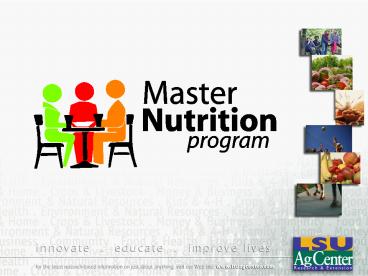... - PowerPoint PPT Presentation
Title: ...
1
(No Transcript)
2
Fruit and Vegetable Extravaganza!
3
Eat Your Colors the Easy Way
- 5 to 9 servings every day
- 1 Fruit serving
- 1 medium-size piece of fruit
- ¾ cup (6 ounces) 100 fruit juice
- ½ cup frozen, canned or fresh cut up fruit
- ¼ cup dried fruit
- 1 Vegetable serving
- ½ cup raw or cooked vegetables
- ¾ cup (6 ounces) 100 vegetable juice
- 1 cup raw, leafy vegetables
4
Eat the Rainbow
- Green
- Yellow or Orange
- Red
- Blue or Purple
- White
5
Ways to Increase Intake
- Have 2 servings at breakfast
- Drink a glass of 100 of fruit/vegetable juice
- Top cereal or pancakes with berries or sliced
bananas - Scramble eggs with chopped vegetables
- Have a smoothie made with fresh, frozen or canned
fruit
6
Ways to Increase Intake
- Choose 2 different colored vegetables at lunch
and supper - Eat salads with romaine lettuce, dark, leafy
lettuce or spinach - Substitute sweet potatoes for white potatoes
- Stir mixed vegetables into soups, stews or
casseroles
7
Ways to Increase Intake
- Have spaghetti with tomato sauce and extra
vegetables - Treat yourself to a fruit salad for dessert
- Season foods with onions, garlic, chives, parsley
or other herbs and peppers
8
Ways to Increase Intake
- Have colorful, healthy snacks
- Grab apples, grapes, oranges, pears or peaches
for quick snacks - Make a smoothie with fresh, frozen or canned
fruit - Munch on raw veggies and low-fat dip
- Try dried fruit with nuts and dry cereal
9
Buying Tips
- Purchase produce that is not bruised or damaged.
- When selecting fresh-cut produce, choose only
those items that are refrigerated or surrounded
by ice. - Bag fresh fruits and vegetables separately from
meat, poultry and seafood products.
10
Storage Tips
- To maintain quality and safety of fresh produce
- Keep perishable produce (strawberries, lettuce,
herbs and mushrooms) in a refrigerator at
temperature of 40 or below. - All produce that is purchased pre-cut or peeled
should be refrigerated.
11
Storage Tips
12
Storage Tips
13
Preparation Tips
- Cut away any damaged or bruised areas.
- Thoroughly wash all produce before eating.
- Wash under running water just before eating,
cutting or cooking. - Never use any detergent or bleach solution.
- Scrub firm produce such as melons and cucumbers
with a clean produce brush. - Dry produce with clean cloth or paper towel.
14
What About Pre-washed Produce?
- If it states on package it is pre-washed, it can
be used without further washing. - As an extra measure of caution, you can wash it
again just before you use it. - Precut or pre-washed produce in open bags should
be washing before using.
15
Health Risks with Raw Sprouts
- Rinsing sprouts first will not remove bacteria.
- To reduce the risk of illness, do not eat raw
sprouts such as bean, alfalfa, clover or radish. - Cook sprouts thoroughly before eating to reduce
risk of illness.
16
Separate for Safety
- Keep produce that will be eaten raw separate from
other foods and from kitchen utensils used for
those products. - Be sure to wash cutting boards, dishes, utensils
and countertops between preparing raw meats or
seafood and produce. - Use kitchen sanitizers on cutting boards and
countertops periodically. - If using plastic or other nonporous cutting
boards, run through dishwasher after use.
17
Fruit and Vegetable Juices
- Select pasteurized products.
- Unpasteurized juices
- Should be kept in the refrigerated section of the
store or on ice. - Must have a warning label regarding foodborne
illness on package. - Fresh squeezed and sold by the glass does not
require warning label.
18
Q As about Fresh Produce
- What is Organic Produce?
- Produce grown without using most conventional
pesticides. - What is ethylene gas and how does it affect
produce? - Gas produced by some fruits and vegetables when
they ripen. Produce harvested in unripened state
will be exposed to ethylene gas to induce
ripening.
19
Q As about Fresh Produce
- What does the use-by date mean on a package of
fresh produce? - It is the last date recommended for peak quality
as determined by manufacturer. - Why are wax coatings used on produce?
- Wax coatings help retain moisture to maintain
quality from farm to table. - Waxes also help inhibit mold growth, protect
produce from bruising and disease and enhance
appearance.
20
Whats in Season?
- Summer
- Beets Berries
- Broccoli Chinese Cabbage
- Corn Cucumbers
- Eggplant Green Beans
- Peaches, nectarines Plums
- Summer squash Tomatoes
- Melons Zucchini
- Okra
21
Whats in Season?
- Fall
- Acorn quash Apples, pears
- Butternut squash Cauliflower
- Figs Garlic
- Ginger Grapes
- Mushrooms Parsnips
- Pomegranates Pumpkins
- Quince Sweet potatoes
- Swiss chard
22
Whats in Season?
- Winter
- Grapefruit Kale
- Leeks Lemons
- Oranges, tangerines Radicchio
- Radishes Rutabaga
- Turnips Broccoli
- Greens mustards, collards, turnip
23
Whats in Season?
- Spring
- Apricots Artichokes
- Asparagus Avocado
- Carrots Collard greens
- Mango Mustard greens
- New potatoes Vidalia onions
- Pineapple Rhubarb
- Spinach Spring lettuces
- Strawberries Sugar snap/snow
- peas
24
References
- FDA Center for Food Safety and Applied
Nutrition - Food Network
- University of California, Davis
- Wellness Encyclopedia of Food and Nutrition
25
(No Transcript)































